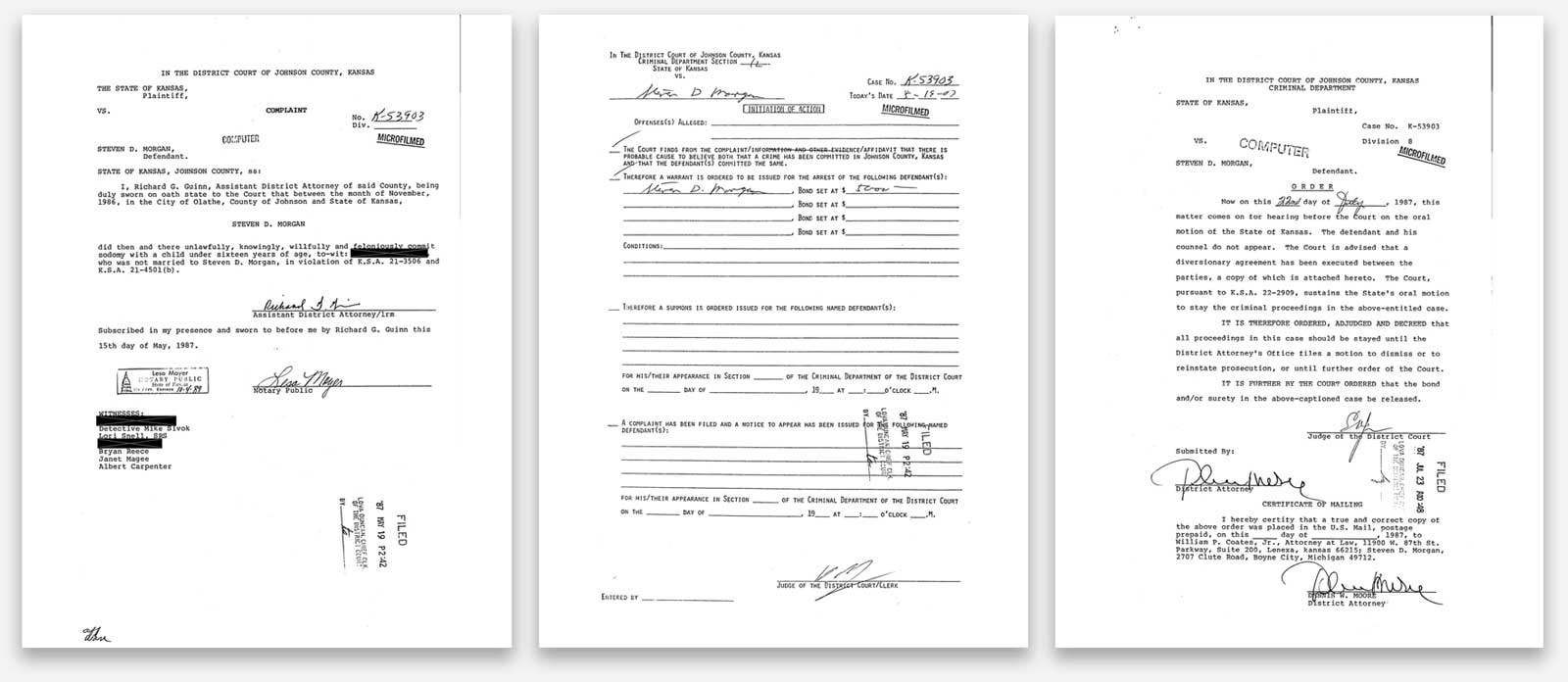WHO IS STEVE MORGAN?
Before founding The Network, Steve Morgan was an ordained leader, church Elder, and youth pastor who was arrested for Aggravated Criminal Sodomy against a teenage boy
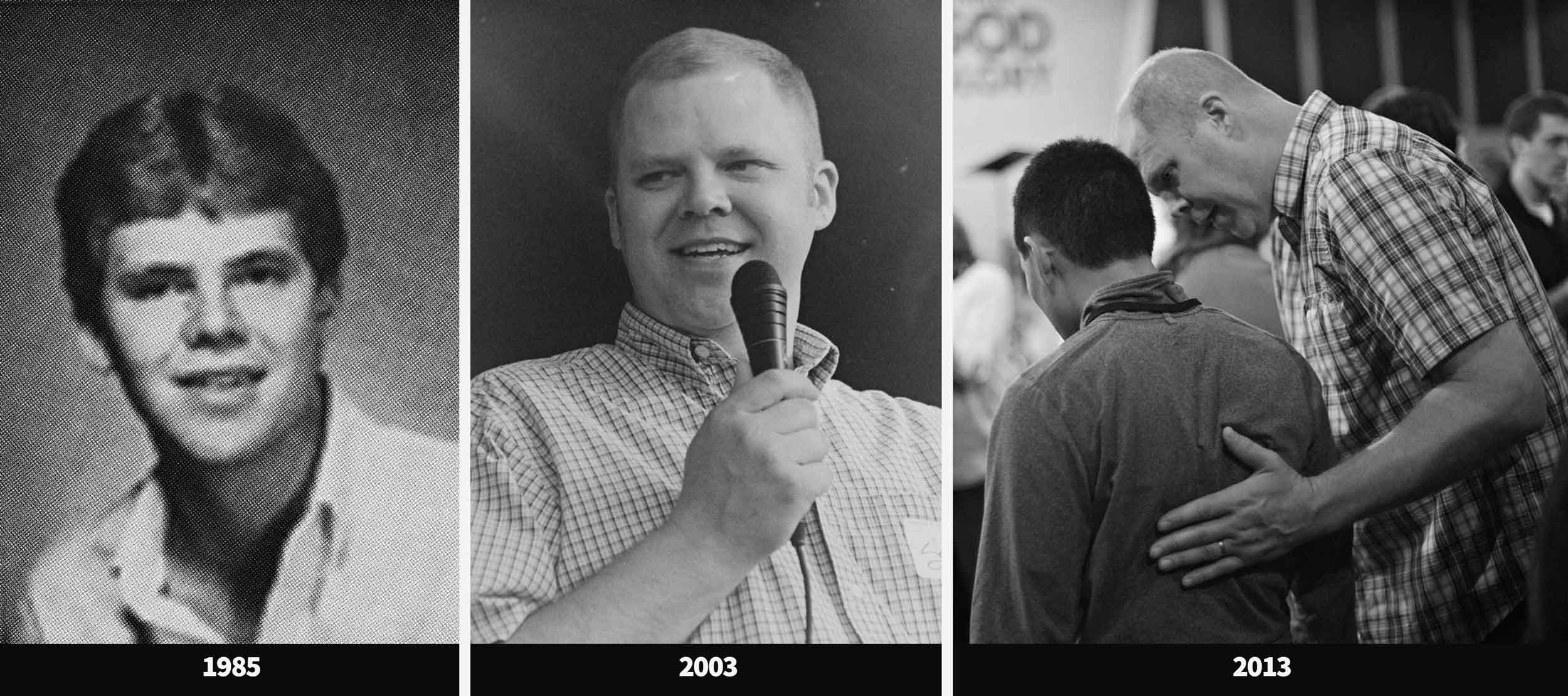
Steve Morgan’s pastoral roles - left to right: 1985 (21 years old) youth summer camp pastor at Park of the Pines in Boyne City, Michigan, and Presiding Elder at RLDS Church in Allendale, Missouri; 2003 (39 years old) lead pastor at Vineyard Community Church in Carbondale, Illinois; 2013 (49 years old) leader of The Network and lead pastor at Blue Sky Church in Bellevue (Seattle), Washington
WHO WAS STEVE MORGAN BEFORE FOUNDING THE NETWORK?
Date Posted: August 15, 2023
JUMP TO SECTION:
- WHO IS STEVE MORGAN? ⇣
- Morgan's CLAIMS ABOUT HIS PAST ⇣
- FAMILY TIES TO RLDS ⇣
- 1982-86: SPIRITUAL LEADER AT GRACELAND COLLEGE ⇣
- 1984: ORDAINED INTO THE PRIESTHOOD ⇣
- 1985: YOUTH CAMP PASTOR AT PARK OF THE PINES ⇣
- 1985: PROMOTED TO PRESIDING ELDER ⇣
- 1987: Arrested and FIRED FROM HIS POSITION AS YOUTH PASTOR ⇣
- 1987: RETURNED TO MICHIGAN ⇣
- 1993: RISING STAR IN VINEYARD DENOMINATION ⇣
- CONCLUSION ⇣
WHO IS STEVE MORGAN?
Steve Morgan is the founder and leader of The Network, an international religious organization which left The Vineyard Association in 2006 under Morgan's direction. Former members describe The Network as fostering a controlling, manipulative, misogynistic, and spiritually abusive culture. Morgan had previously joined Vineyard as a pastor in 1995 when he planted Vineyard Christian Fellowship of Carbondale, Illinois (later called Vineyard Community Church of Carbondale and eventually Vine Church after breaking away from Vineyard).
Before joining The Vineyard Association and founding The Network, Morgan was a rising star holding elder and leadership roles within the Reorganized Church of Jesus Christ of Latter Day Saints (RLDS[1]), including ordained positions as a youth summer Camp Pastor and Presiding Elder (Lead Pastor). Morgan's upward trajectory in RLDS was abruptly halted after he was arrested and subsequently fired in 1987 for allegedly committing aggravated criminal sodomy against a teenage boy in his youth group in Olathe, Kansas.
Leaving The Network sourced this article through extensive newspaper clippings and interviews of people with firsthand knowledge of Morgan's various religious leadership roles before founding The Network, including statements from a member of the alleged victim’s family and the church Elder who hired and fired Morgan as a Youth Pastor.
WHY DOES THIS MATTER?
This matters because Morgan has insinuated for decades that his divine calling from an "unchurched" background into church leadership was a miraculous event in a string of supernatural experiences which propelled him into his role as a pastor and eventually Network president. Further, Network leaders have consistently cited Steve Morgan's "transparency," "integrity," and "character" as part of the evidence of his qualifications. If Morgan has consistently and knowingly mislead his followers on the details of his story, then both his integrity and the supernatural circumstances of his calling should be called into serious doubt.
We invite our readers to compare the following historical record against Morgan’s version of events as described in his 2020 talk “How My Story Shapes Our Network” (audio and transcript linked below). We believe this evidence reveals that Morgan's contemporary framing demonstrates an unequivocal and intentional pattern of deception and rewriting of his own history.
REFERENCES:
[1] The Reorganized Church of Jesus Christ of Latter Day Saints (RLDS) changed its name to Community of Christ in 2001. RLDS will be used for this article as that is what the denomination was called at the time of Steve Morgan’s involvement.
STEVE MORGAN’S CLAIMS ABOUT HIS PAST
In the following 2020 small group core training, while summarizing his religious journey, Steve Morgan claimed he was “unchurched” prior to his experiences at Ziegler Vineyard in 1993 (19m 20s, lines 156 & 200), and that his outsider status made him uniquely qualified to judge a church’s effectiveness (14m 40s, line 158).
STEVE MORGAN: HOW MY STORY SHAPES OUR NETWORK - 2020 Small Group Core Member Training
The average listener will presume that Morgan had never been involved in churches, and that the first time he read the Bible was after his "conversion" when he was 25 years old, both of which are strongly contradicted by the historical record showing Morgan's upbringing, service, and subsequent employment within the RLDS church. (11m 15s, lines 107; 16m 30s, lines 170-176) He made no reference to his family’s ties to the RLDS church, his undergraduate degree at a church-sponsored college, nor his involvement as a church leader; he instead claimed he was a “typical American pagan.” (5m 50s, line 58)
The average listener will presume that Steve Morgan had never been involved in churches, and that the first time he read the Bible was after his "conversion" when he was 25 years old, both of which are strongly contradicted by the historical record showing Morgan's upbringing, service, and subsequent employment within the RLDS church.
Here are some examples of instances where Morgan positions himself as a religious outsider who was baffled at how churches operate:
- “I did not grow up as a Christian. So, my family were maybe what you would call kind of nice on the outside, typical American pagans.” (5m 30s, Lines 57-58)
- “I was a baby Christian born on the sidewalk alone.” (14m 45s, Lines 147-148)
- “I got in my first church home in Southern Illinois. And I had to look a long time... Growing up not a Christian, there were a lot of things that were intuitive to me that: a person should be able to come into a church and — that to Christians, they didn’t see somehow.” (15m 25s, Lines 156-160)
- “I would go into these churches, and everybody was so stiff. They talked to each other, and I did not know what to do. I just, growing up not a Christian, I just could not do it.” (16m 30s, Lines 170-171)
- “I'm just a backwoods punk kid from northern Michigan, but I read 1st Corinthians once…” (18m 5s, Lines 188-189)
- “I walked around and went out the door and left. I thought, ‘I can't do this.’ I had almost given up hope that there was a church where a young man who was unchurched could come in and be a part of it and it makes sense.” (19m 20s, lines 199-201)
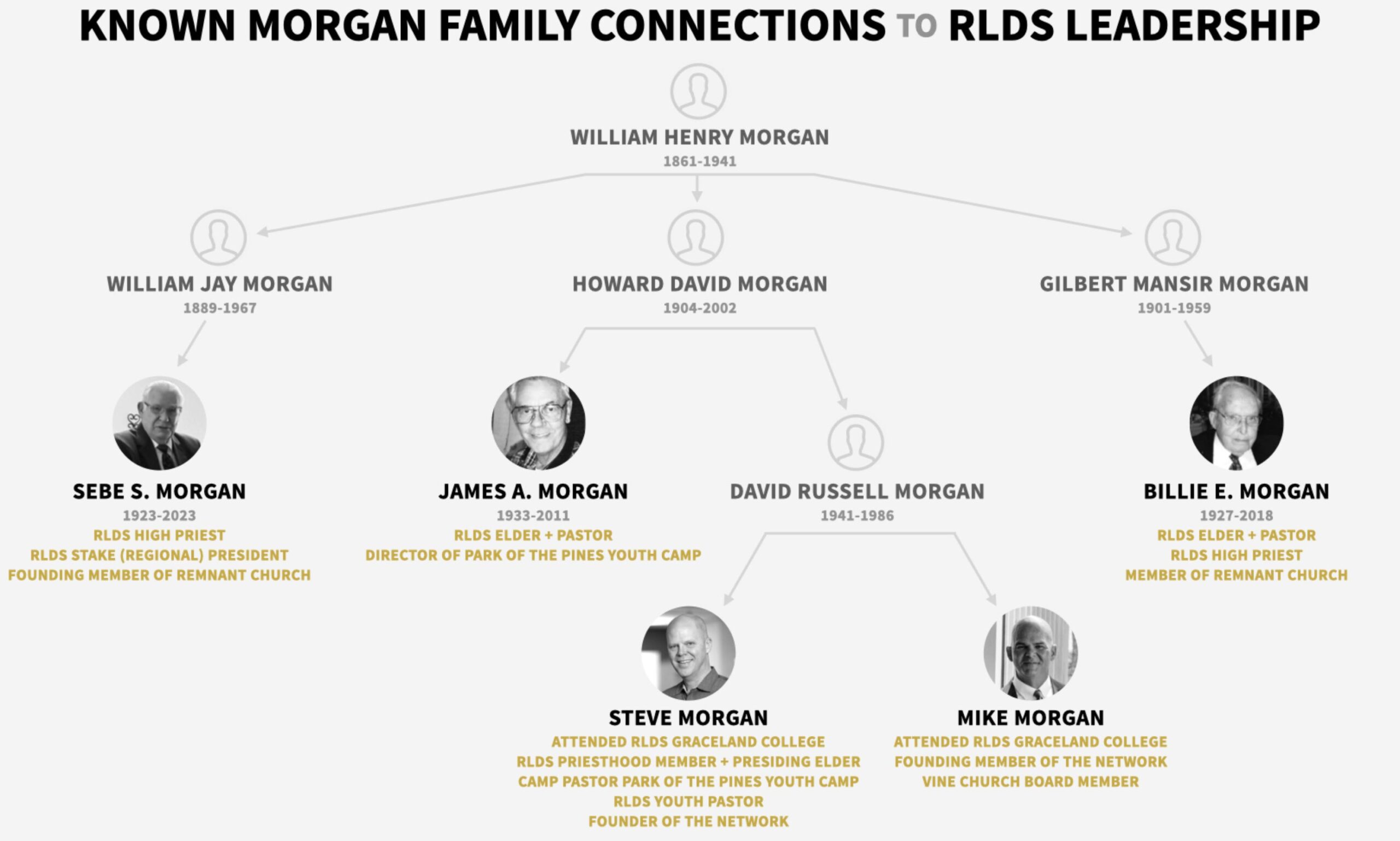
Family Connections to RLDS Leadership: Steve Morgan's extended family includes senior leaders of the Midwest RLDS church: Regional Stake President & High Priest Sebe Morgan, High Priest Billie Morgan, and Pastor & Director of Park of the Pines James Morgan - photos from obituaries, Facebook, and Joshua Church websites
STEVE MORGAN’S FAMILY TIES TO RLDS
WHAT IS THE REORGANIZED CHURCH OF JESUS CHRIST OF LATTER DAY SAINTS?
The RLDS church is distinct from the much larger Church of Jesus Christ of Latter Day Saints (LDS).[1] The two denominations separated in 1844 after the death of founder Joseph Smith. The LDS accepted Brigham Young as their leader and followed him to Salt Lake City, Utah, while the RLDS remained in the Midwest under the leadership of Joseph Smith’s oldest living son. In the early 1900s, the RLDS established their permanent headquarters in Independence, Missouri (a suburb of Kansas City).
Unlike their Utah counterparts, RLDS opposed the practice of polygamy, affirmed the historical Christian concept of the Trinity, and did not introduce the LDS teachings on the Exaltation (the belief in a celestial kingdom where families will govern spiritual descendants in the afterlife). While the Book of Mormon is accepted in RLDS congregations as scripture along with the books in the Protestant Bible, members do not consider themselves Mormon and their teachings emphasize the resurrection of Jesus Christ and salvation by grace alone.[2]
REFERENCES:
[1] The Reorganized Church of Jesus Christ of Latter Day Saints (RLDS) changed its name to Community of Christ in 2001. RLDS will be used for this article as that is what the denomination was called at the time of Steve Morgan’s involvement.
[2] “Our Beliefs.” Community of Christ International Headquarters, cofchrist.org/our-beliefs. Accessed 9 Aug. 2023.
FAMILY TIES TO RLDS
Steve Morgan’s uncle, Elder James Morgan, was a member of the priesthood in the RLDS church and a pastor for 25 years. He was active both in Boyne City, Michigan (the town where Steve grew up) and in nearby Onaway, Michigan.[1] When Steve’s sister was married in 1983, Elder James Morgan performed the wedding in the church in Boyne City, and Steve played guitar and sang at the ceremony.[2] Elder James Morgan was also the director of Park of The Pines,[3] a youth camp where Steve would be installed as Camp Pastor in 1985.[4]
Steve’s extended family included other senior leaders of the Midwest RLDS church. High Priest Sebe (C.B.) Morgan, Steve’s father’s cousin, was the regional President for stakes in Ohio, Missouri,[5] and Michigan.[6] Another of Steve’s father’s cousins, Billie E. Morgan, was High Priest in Onaway, Michigan.[7]
Steve Morgan's extended family included senior leaders of the Midwest RLDS church: Regional Stake President & High Priest Sebe Morgan, High Priest Billie Morgan, and Pastor & Director of Park of the Pines James Morgan.
Both Sebe and Billie took divisive positions after the RLDS denomination passed a resolution to allow women into the Priesthood. Sebe left RLDS to be a founding member of Remnant Church in 1991, a break-off RLDS sect which continued to deny ordination to women.[8] Billie followed Sebe into the newly established Remnant Church.[9] Steve would later take a parallel path while a pastor in the Vineyard Association, establishing The Network as an independent organization in 2006 after he disagreed with Vineyard’s increasing support for ordaining women.[10]
Steve’s choice of college confirms that Morgan had knowledge of his family’s involvement within the denomination and had an inclination to follow them by associating himself with RLDS. After high school, Steve enrolled at the RLDS-sponsored Graceland College in the town of Lamoni, Iowa (750 miles away from his home in Boyne City) for the 1982-1983 school year.[11] Steve’s younger brother, Mike Morgan, followed him to Graceland in 1985.
REFERENCES:
[1]“Obituary,” Chagnon Funeral Home (www.chagnonfh.com : accessed 8 July 2023), Elder James A. Morgan, died 26 October 2011.
[2] “August Weddings: Morgan-Abel.” Petoskey News-Review, 31 August 1983, pp. 9. View full page of newspaper →
[3] “Obituary,” Chagnon Funeral Home (www.chagnonfh.com : accessed 8 July 2023), Elder James A. Morgan, died 26 October 2011.
[4] “Latter Day Saints Host Evangelists.” Petoskey News-Review, 27 June 1985, Thursday, pp. 8. View full page of newspaper →
[5] "Drummond Island Native Assigned to St. Clair Church.” Port Huron Times Herald, 21 February 1987, Saturday, pp. 4. View full page of newspaper →
[6] “Religious Directory.” Akron Beacon Journal, 16 October 1982, Saturday, pp. 28. View full page of newspaper →
[7] “Latter Day Saints Plan Weekend Activities.” Petoskey News-Review, 18 April 1985, Thursday, pp. 8. View full page of newspaper →
[8] Russell, William D. "An RLDS Schismatic Group Finds a Prophet of Joseph's Seed." Dialogue: A Journal of Mormon Thought, Winter 2005, pp. 75.
[9] “Obituary,” Chagnon Funeral Home (www.chagnonfh.com : accessed 8 July 2023), Billie E. Morgan, died 7 May 2018.
[10] Ranvestal, Tony. “Removal of Women from Leadership.” River Vineyard Church Team Vision Meeting, August 2008.
[11] Graceland College. Acacia, 1983: Out of the Blue, Vol 71, 1983, pp. 120-121. View full pages of yearbook →

1986 Graceland College Yearbook: Steve Morgan and Greg Darling in their final year at Graceland College, a four year college sponsored by the Reorganized Church of Latter Day Saints. View full yearbook page →
1982-86: STEVE MORGAN WAS KNOWN AS A SPIRITUAL LEADER AT GRACELAND COLLEGE
Graceland College is a small, private college located in Lamoni, Iowa, a town originally founded in 1870 by RLDS leader Joseph Smith III (Joseph Smith’s oldest surviving son). Lamoni served as the RLDS headquarters from 1880 until the early 1900s, at which point the headquarters was relocated to Independence, Missouri. Graceland College was established in 1895 when RLDS church members donated land for the original campus acreage.[1]
Steve Morgan attended Graceland from Fall 1982 until Summer 1986 (along with classmate and future Network pastor Greg Darling),[2] when enrollment was around 800 students.[3] Steve’s brother, Mike Morgan—future worship leader and board member at Vine Church—began attending Graceland in 1985. Kim,[4] a freshman at Graceland College when Morgan and Darling were seniors, remembered them both as being “young RLDS leaders on campus” and remarked that Steve was known for his piety.
“You could tell that they were going to go back and become pastors… I think that was [Steve’s] whole goal in life, that he was going to lead a church.”
“[Steve Morgan] was just very perfect. Everything was prayer, and he was very over the top… He took his faith very, very seriously.” Kim also remarked that many on campus looked to Steve and Greg as future RLDS leaders. “[Greg and Steve were] definitely ones that were going to be church leaders. You could tell that they were going to go back and become pastors… I think that was [Steve’s] whole goal in life, that he was going to lead a church.”
Kim’s observations are corroborated by newspaper clippings from 1982, which show Morgan and Darling were active as freshmen in a worship and discipleship group called “The Journeymen.” The group organized a special worship service and led Sunday services at the local church in Allendale, Missouri (a 30-minute drive from Graceland's campus).[5]
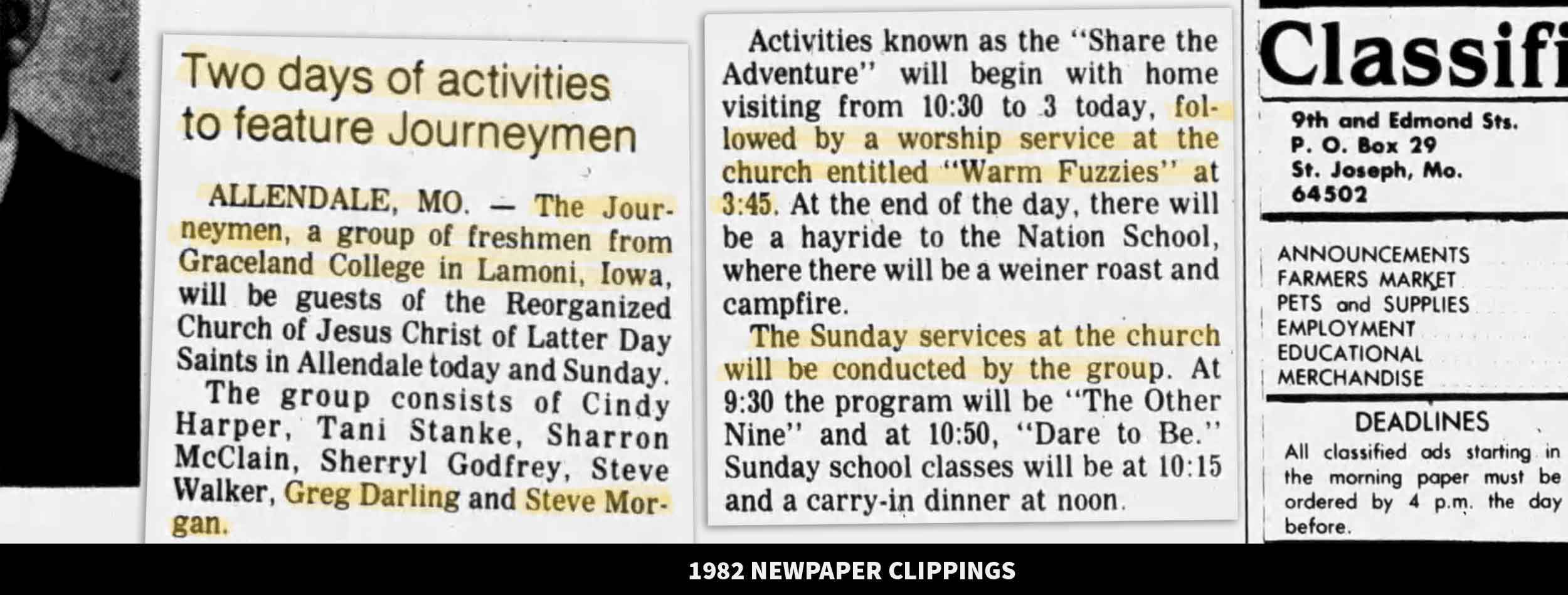
Morgan continued his involvement in the Allendale church throughout his time at Graceland College. One article from 1985 states: “As part of a get-acquainted campaign, Elder [Steve] Morgan and Jim Cole, students at Graceland College, are spending their weekends visiting members and friends near Allendale.”[6] His role as Presiding Elder is covered later in this article.
Morgan also undertook a "contractual assignment" to Michigan in 1985. These assignments, comparable to the two-year "mission" undertaken by young men in the Utah LDS denomination,[7] are church-organized programs where "assignees" like Morgan gain experience in proselytizing and receive training for pastoral ministry.
Morgan also undertook a "contractual assignment" to Michigan, an RLDS program comparable to the two-year "mission" undertaken by young men in the Utah LDS denomination.
Reflecting on his experience on "contractual assignment," Morgan expressed excitement in a 1986 article, noting that it provided him with firsthand insight into RLDS ministry practices as observed "in the field."[8]
Steve Morgan was 22 years old when he graduated from Graceland College in May, 1986, with a degree in Business Education/Administration Services.[9]
REFERENCES:
[1] “The History of Graceland.” Graceland University Website, www.graceland.edu/about/history. Accessed 10th June, 2023.
[2] Graceland College. Acacia Yearbooks, 1983-1986, Volumes 71-74, 1983-1986. View page of 1983 yearbook → | View page of 1986 yearbook →
[3] “History of Graceland University.” 2004-2005 Graceland Class Catalogue, Graceland University, 2004, pp. 2. View pdf →
[4] “Kim” spoke with Leaving The Network on condition of anonymity. Her name has been changed in this article, though her identity has been independently confirmed with other contributors and verified from the 1986 Graceland College yearbook.
[5] “Two Days of Activities to feature journeyman.” St. Joseph, Missouri News-Press Gazette, 13 November 1982, Saturday, pp. 15. View full page of newspaper →
[6] McVicker, Alice. “At the Churches: Easter - The Reorganized Church of Jesus Christ of Latter Day Saints.” St. Joseph, Missouri News-Press Gazette, 6 April 1985, Saturday, pp. 9B. View full page of newspaper →
[7] Baker, Margaret P. “Deseret Book and Herald House: Language Features as Deseret Book and Herald House: Language Features as Expressions of LDS and RLDS Divergences.” Deseret Language and Linguistic Society Symposium, vol. 13, Issue 1, 26-27 March 1987. Via scholarsarchive.byu.edu, accessed Dec. 28, 2023.
[8] Smith, Laurie L. “Faith with Works is Alive at Graceland.” Saints Herald Magazine, vol. 132, no. 9, May 1985, pp. 23. Via catalog.churchofjesuschrist.org, accessed Dec. 28, 2023. View article →
[9] “Morgan Grad from Graceland.” Charlevoix County Press, vol. 107, no. 17, 25 June 1986, pp. 4. View full page of newspaper →

Petoskey News-Review, 21 November 1984, Wednesday, pp. 12: Steve Morgan was ordained into the RLDS office of Elder in the Melchisedec Priesthood by the High Priest John Wolf of Mount Pleasant in November of 1984. View full page of newspaper →
1984: STEVE MORGAN WAS ORDAINED INTO THE PRIESTHOOD OF MELCHISEDEC
Steve Morgan received his ordination into the Melchisedec Priesthood in 1984 from High Priest John Wolf of Mount Pleasant, Michigan, when he was 20 years old and a junior at Graceland College.[1] In the summer of 1985, Morgan continued his Melchisedec Priesthood training through a "contractual assignment" in Michigan.[2]
The Melchisedec Priesthood was created in 1835 by Joseph Smith, founder of the Latter Day Saints movement, to be the primary method for “setting apart” and promoting leaders in his church.[3] Priesthood members within the RLDS church identify future leaders from among their followers through callings they claim are prophetic and divinely inspired. Unlike their LDS counterparts, where priesthood ordination is effectually automatic for all young men when they come of age, RLDS elders often invite followers into leadership after elders receive “dreams, visions, visitations, audible voices or spiritual impressions” for them.[4]
“No one may become an RLDS priesthood member of their own initiative. They must receive a priesthood ‘call’ from one in authority above them.”
Author Paul Trask characterizes it this way: “No one may become an RLDS priesthood member of their own initiative. They must receive a priesthood ‘call’ from one in authority above them.”[3] This process of “designation by inspiration” is similar to the practice Steve Morgan would institute later in The Network. Network members are not allowed to “self promote,” but are instructed to wait to be “identified” by their leaders who are said to have authority over them.
In order of importance, some of the senior offices of leadership within RLDS:[5]
- RLDS President (prophet, seer, and revelator)
- Regional Stake President
- Bishop / Presiding Bishop
- High Priest / Apostle
- Elder / Presiding Elder (equivalent to overseer / lead pastor)
Morgan's responsibilities as an Elder were described in the RLDS Members’ Manual as follows: “It is within the calling of all elders and higher officers to baptize, confirm, ordain, administer the sacrament, teach, preach, expound, exhort, watch over the church and confirm by the laying on of hands, and take the lead of all meetings.” Additionally, elders like Steve Morgan were expected to be “an appendage to the high priesthood” and “assist in many of the duties” which the high priests performed.[5]
After being ordained as a member of the Melchisedec Priesthood, Morgan went on "contractual assignment" in Michigan to proselytize and to be trained in pastoral ministry. The concept of a "contractual assignment" in RLDS is akin to the two-year "mission" undertaken by young men in the Utah LDS denomination.[6]
Morgan progressed no further than “Presiding Elder” during his career in the RLDS denomination before he was fired from the Olathe, Kansas, congregation in 1987.
REFERENCES:
[1] “Latter Day Saints to Hear High Priest from Mount Pleasant.” Petoskey News-Review, 21 November 1984, Wednesday, pp. 12. View full page of newspaper →
[2] Smith, Laurie L. “Faith with Works is Alive at Graceland.” Saints Herald Magazine, vol. 132, no. 9, May 1985, pp. 23. Via catalog.churchofjesuschrist.org, accessed Dec. 28, 2023. View article →
[3] Smith, Joseph. “Authority and offices of Melchisedec Priesthood.” RLDS Doctrine & Covenants 104:1-17, March 28, 1835. View online →
[4] Trask, Paul. “Chapter 11: The RLDS Priesthood System.” Part Way to Utah: The Forgotten Mormons, Refiner’s Fire Ministries, April 10, 1997, pp. 121-126.
[5] “Chapter 5: Relationship Between Ministry and Membership.” Church Members’ Manual: Reorganized Church of Jesus Christ of Latter Day Saints, Price Publishing Company, Copyright 1992, reprinted in 1998 (originally published 1950 by Herald Publishing House). www.centerplace.org/library/books/cmmanual. Accessed 24 May, 2023.
[6] Baker, Margaret P. “Deseret Book and Herald House: Language Features as Deseret Book and Herald House: Language Features as Expressions of LDS and RLDS Divergences.” Deseret Language and Linguistic Society Symposium, vol. 13, Issue 1, 26-27 March 1987. Via scholarsarchive.byu.edu, accessed Dec. 28, 2023.

Steve Morgan was Youth Camp Pastor in the summer of 1985 at Park of the Pines Summer Camp in Boyne City, Michigan. Steve Morgan told at least one pastor in The Network that he had a sexual relationship with a teenage boy during his time “working at a Mormon summer camp.”[5]
1985: STEVE MORGAN WAS YOUTH CAMP PASTOR AT PARK OF THE PINES IN BOYNE CITY, MICHIGAN
Steve Morgan was the Camp Pastor for the youth summer camp at Park of the Pines in Boyne City, Michigan when he was 21 years-old. A newspaper article from the Petoskey News-Review named Morgan as Camp Pastor and listed Gene Beach as the camp director for the RLDS youth camp in the summer of 1985.[1] The St. Joseph, Missouri News-Press Gazette listed Morgan as a “minister” who had “spent the summer directing church youth activities in Michigan.”[2] Additionally, Morgan wrote in a 1986 article for Saints Herald magazine that he had been involved with "more than thirty youth camps and retreats."[3]
Both Morgan's presence as the Camp Pastor at a church-sponsored, youth summer camp and his comments that "Jesus Christ had given his life meaning," bring his claims of being an "unchurched," "American pagan" into serious doubt
Park of the Pines is a church-owned campground which has operated under RLDS leadership since it was established in 1920. The camp’s mission is to “proclaim Jesus Christ and promote communities of joy, hope, love, and peace.” The camp says on its website: “Our mission is about sharing the peace of Jesus Christ in all its dimensions. ‘The peace of Jesus Christ’ encompasses all of the promises, hopes, and blessings of the gospel as revealed by Christ and as affirmed by the Holy Spirit, his promised presence with us.”[4]
Both Morgan's presence as the Camp Pastor at a church-sponsored, youth summer camp whose mission was to “share the peace of Jesus Christ,” and his comments in the Saints Herald that "Jesus Christ had given his life meaning," bring his claims of being an "unchurched," "American pagan" into serious doubt.[3]
STEVE MORGAN TOLD ANOTHER PASTOR IN THE NETWORK THAT HE HAD A SEXUAL RELATIONSHIP WITH A TEENAGE BOY WHILE WORKING AT A SUMMER CAMP
Steve Morgan’s role as a Camp Pastor raises troubling concerns. Morgan seems to have disclosed to at least one pastor in The Network that he sexually assaulted a teenager while at a summer camp.
Sándor Paull, vice president of The Network and lead pastor of Christland Church in College Station, Texas, relayed the following information in his July 17, 2022, defense of Steve Morgan:
“He was working at a Mormon summer camp in some capacity… Steve was 22. And at that Mormon summer camp, there was a young man who was 15. And the events of whatever the day was, went into the legal system, the judge followed it through, I don't remember what the actual attorney word for it is. Charges were dropped or settled or satisfied, or some attorney-ish thing.”[5]
We simply do not know what Steve Morgan meant by telling Sándor Paull that the sexual assault occurred during his time “working at a Mormon summer camp.”
This version of events conflicts with court records that indicate Morgan was arrested for committing aggravated criminal sodomy against a teenage boy in his youth group in Olathe, Kansas, not against a camper in Boyne City, Michigan.[6] Records indicate the alleged assault for which Morgan was arrested happened in November 1986, sixteen months after he was a Camp Pastor at Park of the Pines.
Perhaps Morgan falsified his confession to Paull to obfuscate the location of the assault. Perhaps Morgan revealed details of a separate, unreported assault altogether. Either way, unless additional victims come forward, or an investigation is conducted, Paull's description raises more questions than those it is attempting to answer. We simply do not know what Morgan meant by telling Paull that the sexual assault occurred during his time “working at a Mormon summer camp.”
REFERENCES:
[1] “Latter Day Saints Host Evangelists.” Petoskey News-Review, 27 June 1985, Thursday, pp. 8 View full page of newspaper →
[2] McVicker, Alice. “At the Churches - The Reorganized Church of Jesus Christ of Latter Day Saints.” St. Joseph, Missouri News-Press Gazette, 7 September 1985, Saturday, pp. 7B. View full page of newspaper →
[3] Morgan, Steve. “Youth Camp—Prescription for Troubled Teens.” Saints Herald Magazine, vol. 133, no. 5, May 1986, pp. 21. View article →
[4] “We go back a long way: History and Mission.” Park of the Pines Website, www.winnie-bill.wixsite.com/park-of-the-pines. Accessed 10th June, 2023.
[5] Paull, Sandor. "Christland Church Response to Allegations Against Network Founder Steve Morgan", Christland Church, July 17th, 2022, timestamp 0:13:00, Line 151.
[6] District Court, Johnson County, Kansas. Kansas vs Steven D Morgan. Johnson County court records, Case number K0053903. www.jococourts.org. Accessed 6 July 2022.
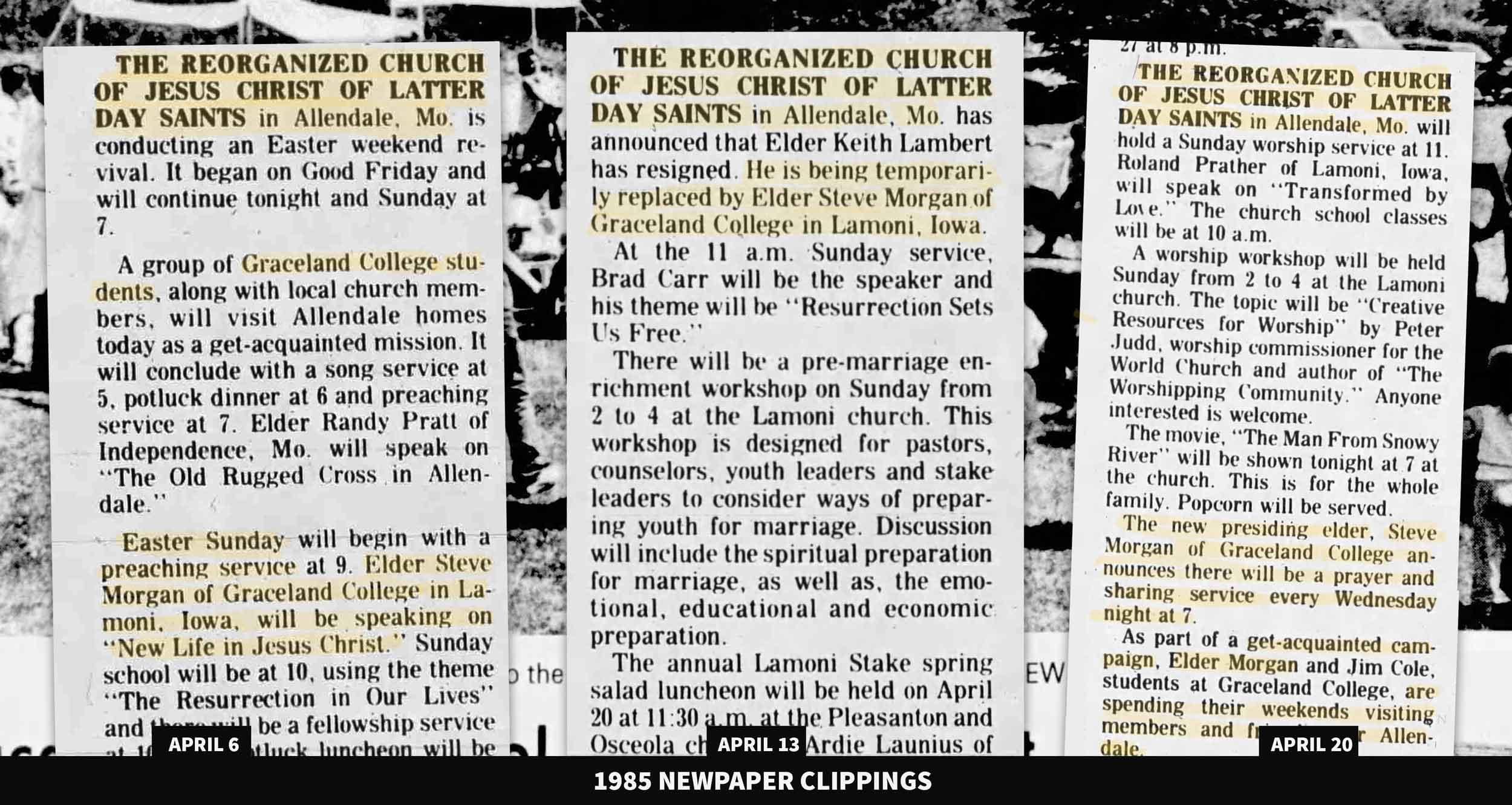
Steve Morgan’s leadership roles as an ordained elder: Elder in Allendale, Missouri, preaching message titled “New Life in Jesus Christ” - View full page → : Replaced resigning elder at Allendale - View full page → : Presiding Elder (lead pastor) instituting weekly “prayer and sharing” services - View full page →
1985: STEVE MORGAN WAS PROMOTED TO PRESIDING ELDER IN ALLENDALE, MISSOURI
Steve Morgan began to fulfill his responsibilities as an ordained member of the Priesthood of Melchisedec to “teach, preach, expound, exhort, watch over the church… and take the lead of all meetings”[1] when he was named as the Presiding Elder in 1985 at the RLDS congregation at Allendale, Missouri, a 30-minute drive from Graceland's campus in Lamoni, Iowa.[2]
Articles printed in the Missouri News-Press Gazette reveal that Morgan preached a sermon on Easter Sunday, April 7, 1985, at the Allendale church titled “New Life in Jesus Christ.”[3] A week later, Elder Keith Lambert resigned and Morgan replaced him as Presiding Elder (equivalent to lead pastor). Within seven days of becoming Presiding Elder, Morgan instituted new weekly prayer and sharing sessions for his congregation.[4]
Steve Morgan preached a sermon on Easter Sunday, April 7, 1985, at the Allendale church titled “New Life in Jesus Christ.”
According to a contemporary article in the Kansas City Star, the role of Presiding Elder was a key leadership position and required the support of the entire congregation (as well as surrounding congregations).[5] The exact tenure of Morgan’s time as Presiding Elder is unknown. He again preached the Easter sermon at Allendale in 1986, but was not introduced with the title “Presiding Elder.” The 1986 article indicates that Morgan preached the Easter sermon because Pastor Daniel Long was out of town at a men’s retreat that Sunday.[6] It is reasonable to assume Morgan was filling in for Pastor Long on Easter 1986 because Morgan remained an Elder/Overseer in the Allendale Church while Long assumed the role of primary pastor.
These articles indicate Steve Morgan experienced a rapid rise to senior church leadership in an established congregation as a 21-year-old. This trajectory starkly contrasts with his characterization of himself as an “unchurched” young man who experienced significant struggle to find a church community where he fit in.
REFERENCES:
[1] “Chapter 5: Relationship Between Ministry and Membership.” Church Members’ Manual: Reorganized Church of Jesus Christ of Latter Day Saints, Price Publishing Company, Copyright 1992, reprinted in 1998 (originally published 1950 by Herald Publishing House). www.centerplace.org/library/books/cmmanual. Accessed 24 May, 2023.
[2] McVicker, Alice. “At the Churches - The Reorganized Church of Jesus Christ of Latter Day Saints.” St. Joseph, Missouri News-Press Gazette, 13 April, 1985, Saturday, pp. 11B. View full page of newspaper →
[3] McVicker, Alice. “At the Churches: Easter - The Reorganized Church of Jesus Christ of Latter Day Saints.” St. Joseph, Missouri News-Press Gazette, 6 April 1985, Saturday, pp. 9B. View full page →
[4] McVicker, Alice. “At the Churches - The Reorganized Church of Jesus Christ of Latter Day Saints.” St. Joseph, Missouri News-Press Gazette, 20 April 1985, Saturday, pp. 3E. View full page →
[5] Schofield, Matthew. "Split was Hurting Church, Officials Say.” Kansas City Star, July 8th, 1987, Thursday, pp. 4. View full page of newspaper →
[6] McVicker, Alice. “Events Wind Up Lenten Season - The Reorganized Church of Jesus Christ of Latter Day Saints.” St. Joseph, Missouri News-Press Gazette, 22 March 1986, Saturday, pp. 5D View full page of newspaper →
Court documents for case number K0053903 (Kansas vs Steven D Morgan), occurring in Johnson County, Kansas in 1986. The arresting charges were statutes KSA 21-3506 (Aggravated Criminal Sodomy against a minor) and KSA 21-4501b (Class B Felony).
1987: STEVE MORGAN WAS FIRED AFTER A YOUTH GROUP MEMBER REPORTED STEVE HAD SEXUALLY ASSAULTED HIM
Steve Morgan was arrested in 1987 for allegedly committing aggravated criminal sodomy against a minor in 1986 while a youth pastor in Johnson County, Kansas (greater Kansas City Metro area).[1]
Located 30 miles from the worldwide RLDS headquarters in Independence, Missouri, the Olathe Church which hired Morgan was a large, active community lead by Pastor E. A. Carpenter.[2] One former church member reported that at 250 members, it was one of the largest RLDS congregations in the world.
Morgan was hired as a youth pastor at Olathe to lead programs for junior high and high school children. His resume for the position would have made him appear well suited for the role: he had served as Youth Camp Pastor the previous summer at Park of the Pines, and he had some responsibilities for youth programming in the Allendale, Missouri, church where he had been Presiding Elder (a 1986 news clipping about the Allendale congregation advertises that 7th-9th grade boys and girls should contact Morgan for transportation to a Valentine's Day party).[3] Morgan wrote in 1986 that "hundreds of young people" had been impacted by the youth camps he had been involved with.[4]
Former Church Elder: “I called the police within 24 hours of talking to [the victim] and [the victim’s] parents. To protect [the victim] and all the other youth, I fired Steve immediately and forbid him from talking to any youth in the congregation.”
A member of the alleged victim’s immediate family, speaking under the condition of anonymity, told Leaving The Network, “In the 80’s, the churches were starting to hire youth leaders. It wasn’t a voluntary position anymore, because they were realizing that those positions were influential. Now, it’s very common to have paid youth leaders. But, before that, they were volunteers. They had an opening at Olathe, Steve applied, and became youth leader there.”
The alleged victim’s family became involved with Morgan's youth ministry, opening their home and creating a space for the youth group. “We had a pool, lived on two acres, had a volleyball net in our backyard, and we sponsored a lot of youth events. Steve was there with the youth at our house often.”
An Elder of the church reported Morgan to the police in 1987 after the alleged victim told the Elder that Steve had molested him in November of 1986. Under the condition of anonymity, this Elder said in a written statement to Leaving The Network, “I am the one who called the police to prosecute. I did all I could. I called the police within 24 hours of talking to [the victim] and [the victim’s] parents. To protect [the victim] and all the other youth, I fired Steve immediately and forbid him from talking to any youth in the congregation. I made Steve call the police himself to get permission to leave the state, and then saw to it that he left.”
“The hardest thing for our family was that even though Steve Morgan was admitting this himself verbally, there were people who supported him because they just loved him. He had this quality about him, and people did not want to believe this.”
The state of Kansas began criminal legal proceedings against Steve Morgan for the charge of Aggravated Criminal Sodomy in May, 1987, and a warrant was issued for Morgan's arrest.
The family member recalled that some members of the congregation continued to support Morgan, even after the alleged sexual assault became public. “People at the church could not believe this — even when Steve called a meeting and confessed to it! That is how good he was. They supported him… The hardest thing for our family was that even though he was admitting this himself verbally, there were people who just supported him because they just loved him. He had this quality about him, and people did not want to believe this.”
REFERENCES:
[1] District Court, Johnson County, Kansas. Kansas vs Steven D Morgan. Johnson County court records, Case number K0053903. www.jococourts.org. Accessed 6 July 2022.
[2] E. A. Carpenter was reported as the pastor of the Olathe RLDS Church in Olathe Daily News listings from 1986 to 1988. At this time we do not know E. A. Carpenter’s full tenure at the Olathe RLDS Church. “Olathe Schedule of Church Services.” Olathe Daily News, 5 April, 1986, Saturday, pp. 5A. View full page of newspaper → and 17 December, 1988, Saturday, pp. 5A. View full page of newspaper →
[3] McVicker, Alice. “At the Churches - The Reorganized Church of Jesus Christ of Latter Day Saints.” St. Joseph, Missouri News-Press Gazette, 8 February 1986, Saturday, pp. 4C. View full page of newspaper →
[4] Morgan, Steve. “Youth Camp—Prescription for Troubled Teens.” Saints Herald Magazine, vol. 133, no. 5, May 1986, pp. 21. View article →
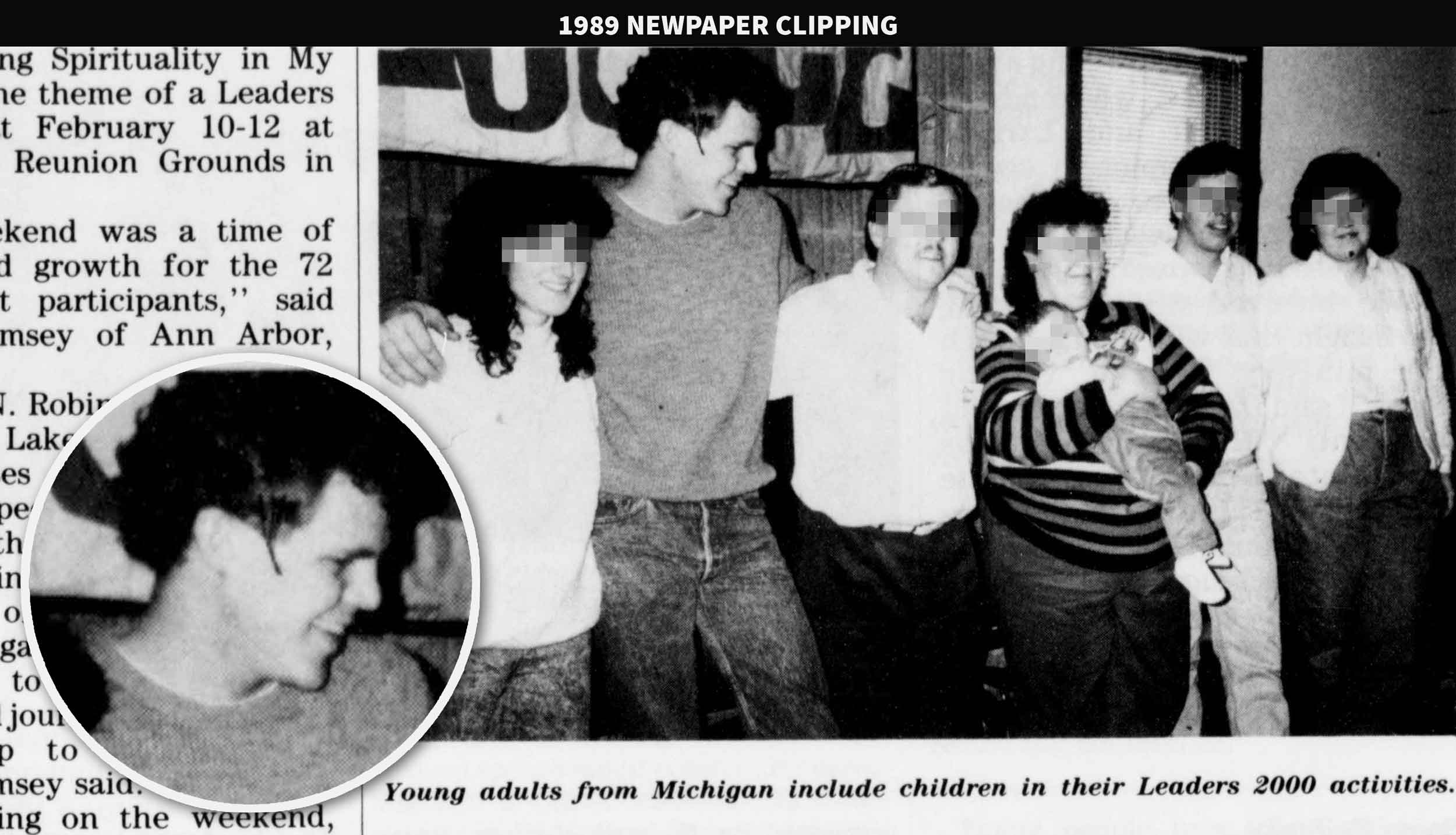
1989 photo of someone matching the description of Steve Morgan with young adults and children at "Leaders 2000" (an RLDS program for "young adults to discover and develop personal and spiritual gifts") at Blue Water Campground in Michigan
1987: STEVE RETURNED TO MICHIGAN AFTER BEING FIRED IN KANSAS
An investigation from a private detective revealed that Steve Morgan returned to Michigan and had taken up residence near Mount Pleasant by December 1987. In 1989, he moved within half a mile of the Mount Pleasant RLDS Church. Leaving The Network could not determine if the High Priest who ordained Steve Morgan into the Melchisedec Priesthood in 1984, Brother John Wolf, was still active in Mount Pleasant at that time.
Steve Morgan's rising star trajectory in the RLDS denomination ended after his arrest and firing in Olathe, Kansas.
An unverified claim posted to Reddit alleges that Morgan continued his involvement with RLDS while in Mount Pleasant. “I dated Steve in 1990 when he was a part of a Leaders 2000 group of young adults. We met on a church property known as Bluewater, in MI.”[1] A photo of someone matching the description of Morgan appeared in the June, 1989 issue of Saints Herald Magazine at a "Leaders 2000" program for RLDS young adults and children at the Blue Water Campground.[2] An uncredited young man in the accompanying article said, "I'm working some things out with God. I need acceptance and support, and I get that from the babies and their parents as they let me share responsibility."
Bluewater, like Park of the Pines, is a campground and camp facility owned and operated by RLDS (now called Community of Christ).[3] The Bluewater property is a two hour drive from Mount Pleasant.
A photo of someone matching the description of Morgan appeared in the June, 1989 issue of Saints Herald Magazine at a "Leaders 2000" program for RLDS young adults and children at the Blue Water Campground.
If information placing Morgan at Bluewater is true and he was active in RLDS ministry in a camp with youth in June 1989, he may have violated item 10 of his diversion agreement which stated, "Defendant shall not be involved with any youth organizations during period of Diversion." Morgan was bound by the terms of his diversion agreement until July, 1990.
Regardless, Steve Morgan's rising star trajectory in the RLDS denomination ended after his arrest and firing in Olathe, Kansas.
Morgan's Masters degree research on the boundary permeability of 18 to 25 year-old students is notable given he would later focus The Network's resources on recruiting college students and planting churches in college towns.
Morgan continued to live in the Mount Pleasant area while he completed postgraduate courses at Central Michigan University, and he obtained his Masters in Interpersonal & Public Communications in May, 1991. For his Master's Thesis Morgan studied 18 to 25 year-old students to determine what factors contributed to their boundaries being either “rigid and impermeable” (meaning “clearly defined and difficult to penetrate”) or “diffuse and permeable” (meaning “boundaries that fluctuate freely and are easily permeated”). His research findings suggested that young people transferred the boundaries they held with their families to relationships with those outside their families when they moved away to attend college.[4] Morgan's research is notable given he would later focus The Network's resources on recruiting college students and planting churches in college towns.
REFERENCES:
[1] u/hotellefleurs. "Who is Steve Morgan - before Carbondale?" Reddit, 22 March 2022, www.reddit.com. View screenshot of post →
[2] “Michigan Young Adults Develop Spirituality.” Saints Herald Magazine, vol. 136, no. 6, June 1989, pp. 39. Via catalog.churchofjesuschrist.org, accessed Dec. 28, 2023.
[3] “About.” Blue Water Campground Website, www.bluewatercampground.com. Accessed 21st July, 2023.
[4] Morgan, Steve. "Young Adult Interpersonal Conflict and Family Boundary Permeability." Central Michigan University, 1991. Read Steve Morgan's Master's Thesis →

Excerpts from one of the dreams Steve Morgan claimed to receive from God. Steve told the congregation of Ziegler Vineyard and his other followers that the dream meant he should start his own church in Carbondale, Illinois. — from "Our Story and How We Do Church," pp. 19-20.
1993: RISING STAR IN THE VINEYARD DENOMINATION
Morgan claimed he experienced a religious awakening and began hearing unusual messages from Jesus during his period in Mount Pleasant, Michigan. He described these divine messages as seeming “absurd” (14m 50s, Line 146-147), citing the example of hearing Jesus command him to pursue his PhD in Carbondale, Illinois, and find his “first church home” in Southern Illinois (14m 25s, Lines 144-158).
These revelations offered a supernatural explanation for Morgan's rapid rise in the Vineyard denomination. Not long after being installed as a small group leader at the Ziegler Vineyard in 1993, Morgan claimed to receive visions and dreams from God which prophesied he would gather the “cream of the crop” of Carbondale and produce a “quickly maturing harvest.”[1] He achieved the position of lead pastor of his own church in 1995, two years after entering the Vineyard organization.
Steve Morgan’s swift climb through the ranks of Vineyard leadership began shortly after his charges were formally adjudicated through the fulfillment of his diversion agreement (ensuring they would not show up on his permanent record), the details of which Steve failed to disclose to Vineyard officials.
Viewed from a spiritual perspective, some may see in his account a deeply spiritual man who was propelled by special revelations from God.
On the other hand, we note that Steve Morgan’s swift climb through the ranks of Vineyard leadership began shortly after his charges were formally adjudicated through the fulfillment of his diversion agreement (ensuring they would not show up on his permanent record), the details of which Morgan failed to disclose to Vineyard officials. Examined through this lens, his actions and hyper-spirituality could be viewed as willful attempts to obfuscate the truth and offer spiritual explanations for manipulative and abusive behavior (described in the article 8 Signs of a Dysfunctional Church).
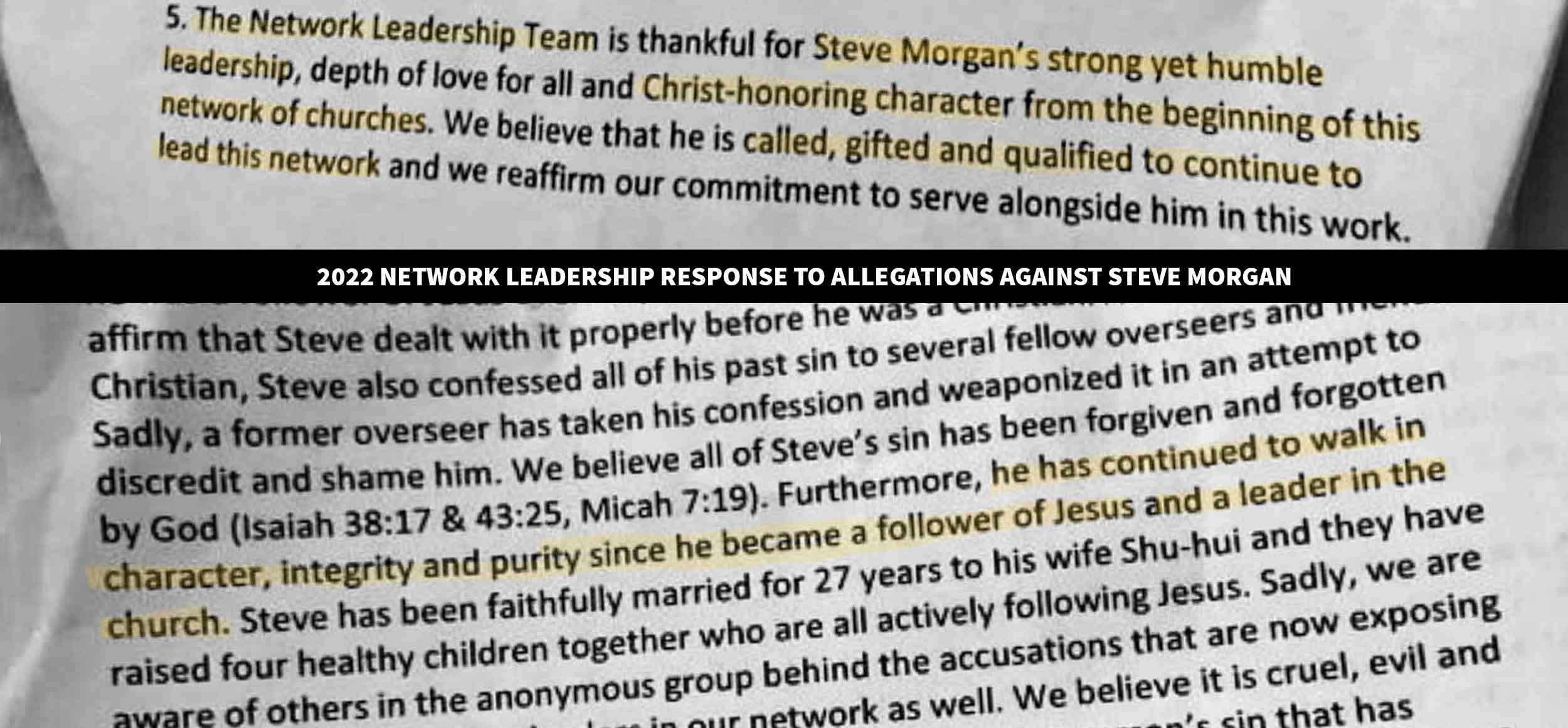
A letter from The Network Leadership Team and all Lead Pastors distributed within The Network starting July 10, 2022, defended Steve Morgan after details of his arrest for alleged sexual assault were published. The letter claimed Steve has demonstrated "Christ-honoring character from the beginning" of The Network and asserted Steve "has continued to walk in character, integrity and purity" since becoming a pastor in The Network. — Read the full letter →
CONCLUSION
After details of Steve Morgan’s arrest for alleged sexual assault were published in 2022, Casey Raymer, lead pastor of Vine Church in Carbondale, Illinois, defended Morgan by saying he was grateful for the “culture of transparency” which Morgan created when founding Vine Church and The Network “in order that nothing would ever be hidden.”[1]
Scott Joseph, lead pastor of High Rock Church in Bloomington, Indiana, likewise praised Morgan’s integrity and said Morgan had “been honest and transparent and forthcoming, every step of the way.”[2] Joseph also claimed many of the facts which had become public about Morgan, including his role as a youth pastor at the time of his arrest for Aggravated Criminal Sodomy against a teenager, contained “significant distortions.”[3]
Contrary to Network leaders' refrains of integrity and transparency, Steve Morgan and his intermediaries misled and deceived their followers and the public.
Further, on July 10, 2022, Network leaders distributed a letter, addressed from the Network Leadership Team and all Lead Pastors, which celebrated Morgan’s “Christ-honoring character” and claimed he had “continued to walk in character, integrity and purity” since he became a leader in The Network.[4]
Contrary to these refrains of integrity and transparency, Steve Morgan and his intermediaries misled and deceived their followers and the public.
Morgan’s rise to prominence within the Vineyard Association in the 90's and early 2000's was predicated on the fiction of an unchurched, "typical American pagan"with a supernatural calling rather than the truth: Steve Morgan possessed years of education, ministry, and preaching experience as a lay leader and ordained pastor, and belonged to an established Morgan family lineage of church leadership.
Steve Morgan maintained a decades-long campaign to methodically rewrite his past and re-imagine himself as the reluctant church leader when leading churches is practically all he has ever done and all he has wanted to do.
Upon joining the Vineyard Association, Morgan wiped his ecclesiastical slate clean, then cast himself as a religious outsider and underdog with no prior church experience. His followers conferred their trust onto him without knowing he allegedly committed a violent, sexual act against a teenage member of the youth ministry for which he was previously employed.
This willful and sustained betrayal of trust rises above concealing an alleged isolated incident of heinous sexual violence. Rather, Morgan maintained a decades-long campaign to methodically rewrite his past and re-imagine himself as the reluctant church leader when leading churches is practically all he has ever done and all he has wanted to do.
Rather than serving as a model of integrity and virtue, Morgan’s dishonesty about his religious history, his arrest for alleged sexual assault against a teenage member of his church, and the documented cases of systemic spiritual abuse in The Network he founded serve as stark reminders of the dangers of unchecked authority and charismatic leadership.
Steve Morgan did not respond to requests for comment on the information presented in this article.
REFERENCES:
[1] Raymer, Casey. “Team Vine: Defense of Steve Morgan.” Vine Church, 10 July 2022, timestamp 5m 14s.
[2-3] Joseph, Scott. “Family Meeting: Defense of Steve Morgan.” High Rock Church, Timestamps: Part 2 - 14m 30s & Part 1 - 13m 0s
[4] “Response to Allegations Against Steve Morgan and Our Network.” The Network Leadership Team and Lead Pastors, 10 July, 2022.
FURTHER READING:
HISTORY OF THE NETWORK: Key milestones in the development of Steve Morgan's Network of churches
HELP OTHERS HEAL
Consider donating to the National Association for Christian Recovery (NACR), a 501.c.3 non-profit whose primary purpose is to help provide resources to recover from abuse (including spiritual abuse) and addiction. Leaving The Network admires the work of NACR but is not associated with their organization.
